Movies and theaters are coming back. But what about L.A.’s treasured art houses?
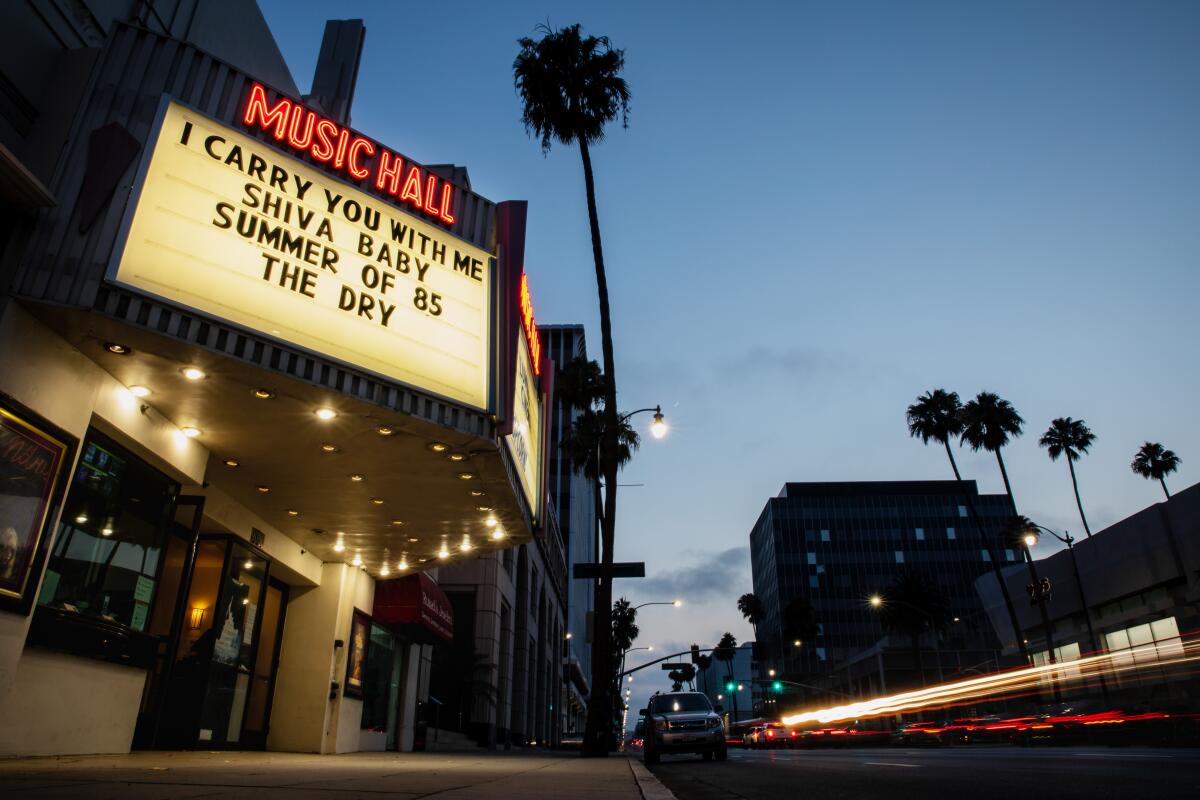
- Share via
During the podcast interview in which Quentin Tarantino announced his purchase of Los Feliz’s beloved Vista Theatre, the two-time Oscar winner made a bold prediction about the future of film exhibition: that “boutique” movie houses will experience a resurgence after the COVID-19 pandemic.
“I do think boutique cinemas will actually thrive in this time,” Tarantino said on Dax Shepard’s “Armchair Expert” show, while pooh-poohing the big chains’ luxury amenities such as dine-in service and recliner seating as a detriment to the cinematic experience. “I got a living room. I want to go to a movie theater.”
That message was heartening for Peter Ambrosio, co-owner of the three-screen Lumiere Cinema at the Music Hall in Beverly Hills. Ambrosio, a former employee of the Music Hall’s former operator Laemmle Theatres, took over the spot in 2019 with two other Laemmle alumni, Lauren Brown and Luis Orellana.
The team had reopened the venue just a handful of months before the shutdown happened in March 2020. The pandemic was especially difficult for the team behind the Lumiere, as they survived an attempt by another company to take over the lease at the space.
“That was a phrase that got kicked around our box office,” said Ambrosio, regarding Tarantino’s “boutique cinemas” reference. “It was music to my ears in terms of him discussing it that way.“
But if the “Once Upon a Time ... in Hollywood” director is correct about the impending revival of the indie movie theater, that prediction will clearly take awhile to come true. Even in Los Angeles, a haven for cinephiles, the movie business’ comeback has been slow going for many of the area’s independent circuits, art houses and revival cinemas.
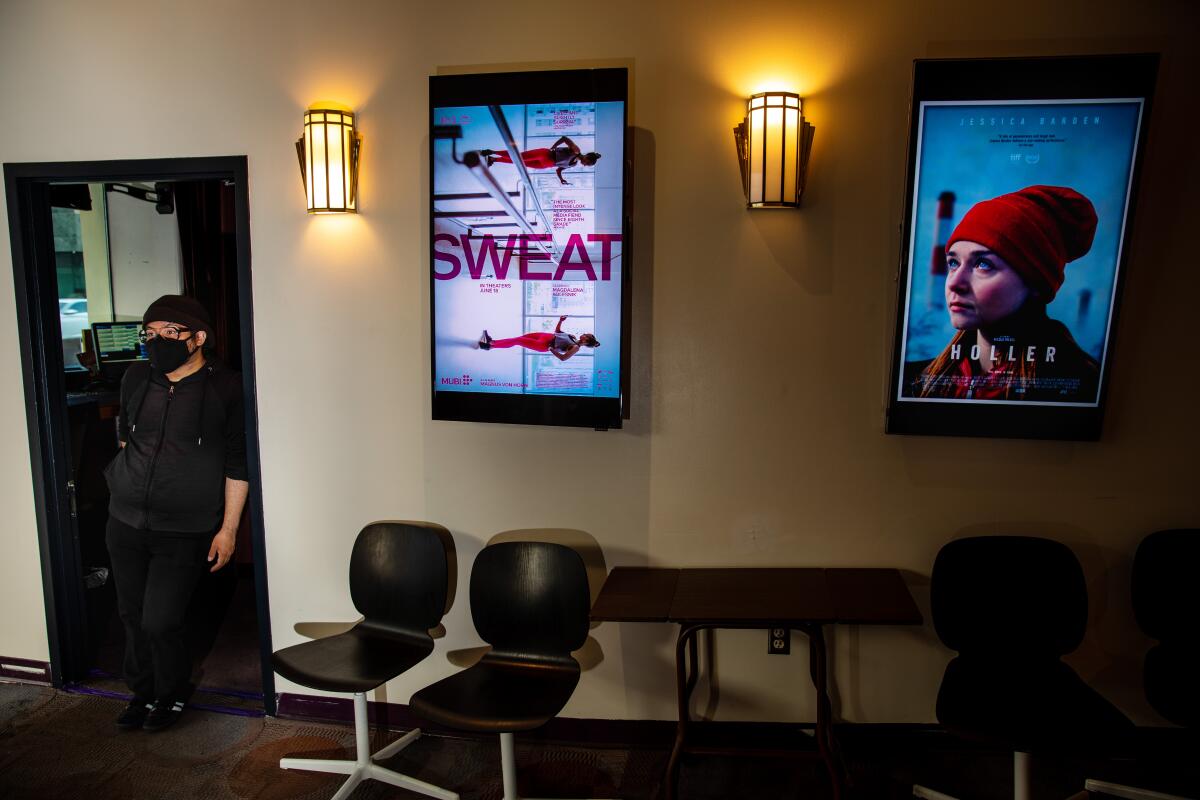
While big chains benefit from a slow but increasingly steady string of blockbusters such as “Godzilla vs. Kong,” “A Quiet Place Part II,” “F9: The Fast Saga” and “Black Widow,” smaller operators are struggling with a combination of major challenges.
Among the difficulties are a lack of fresh, popular indie films, a primarily older target audience that is more hesitant to venture out than their younger counterparts, plus the financial challenges of ramping up business after more than a year of no revenue.
Though some recent specialty releases have drawn audiences, such as Questlove’s historical music documentary “Summer of Soul” and Janicza Bravo’s outrageous comedy “Zola,” most of the hotly anticipated indies aren’t expected to start hitting the big screen until the fall, typically the sweet spot for Oscar hopefuls.
Many of the movies that have come out have been also available through streaming and video-on-demand services. “Summer of Soul,” for example, is on Hulu while in theaters.
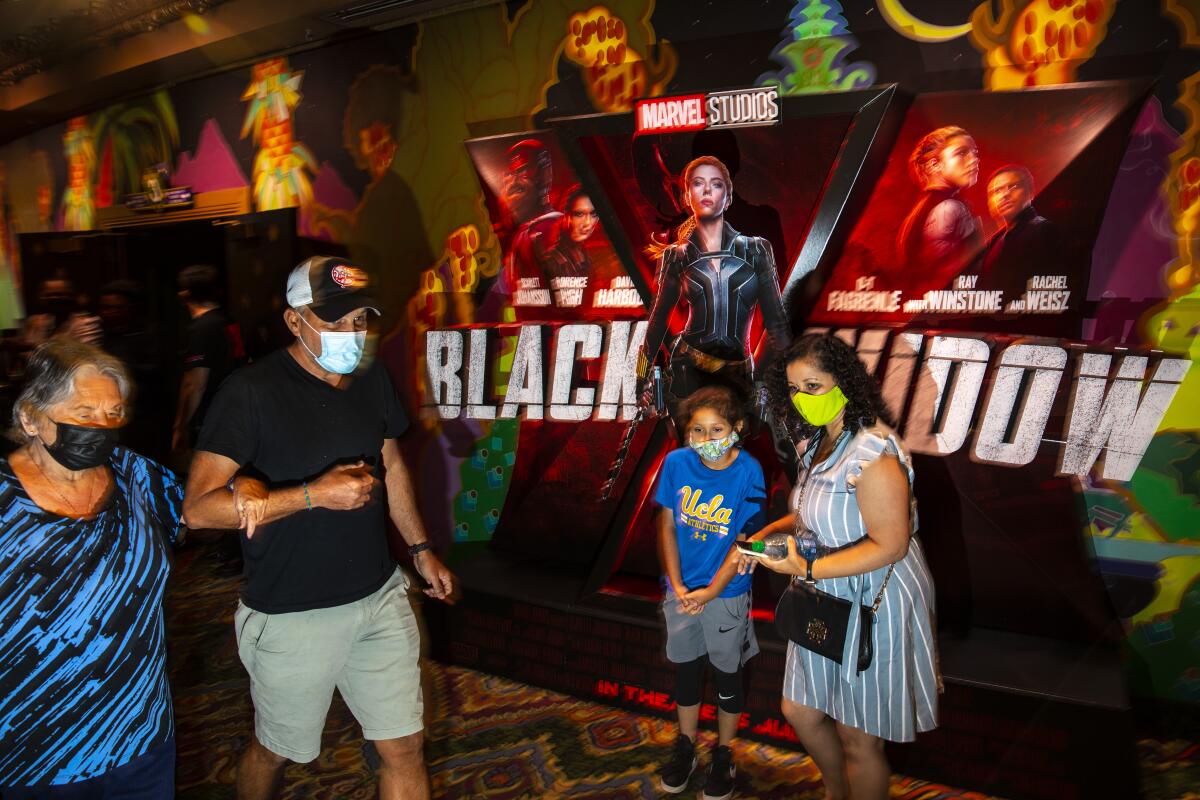
Despite some big films, domestic ticket sales industrywide are improving but still far behind pre-pandemic levels, according to analysts. MKM Partners analyst Eric Handler estimated that, even with the $80-million opening of “Black Widow,” total domestic ticket sales were only about 60% to 65% back to normal. Operators such as Landmark Theatres and Laemmle Theatres have had to resort to filling out their screens with the Hollywood tent poles more so than usual.
“It’s clearly rebounding,” said Paul Serwitz, president and chief operating officer of West Hollywood-based Landmark, which operates three Los Angeles locations, including the 12-screen Landmark on Pico Boulevard. “We’ve benefited from some of that industry uptick, but not as much as the mainstream players.”
Greater Los Angeles’ culture of independent movie theaters was already under threat before COVID-19 shut down the industry, thanks to competition from streaming services and international chains that have spent hundreds of millions of dollars to retrofit their auditoriums and lobbies. Major operators such as AMC and Cinemark reopened as soon as state and local officials allowed. AMC, the world’s biggest chain, just posted its highest weekend attendance since the pandemic, with 3.2 million global admissions Thursday through Sunday.
Many smaller exhibitors, though, were slower to get back on their feet, having struggled from the industry’s previous attempts to restart.

Some, like ArcLight Cinemas and Pacific Theatres, never reopened at all. Parent company Pacific Theatres Exhibition Corp. last month filed to liquidate its assets through Chapter 7 bankruptcy. The beloved Cinerama Dome and the attached Hollywood ArcLight, excluded from the bankruptcy filing, remain closed.
Dallas’ Studio Movie Grill and Austin-based Alamo Drafthouse, both dine-in theater circuits with a presence in L.A., filed for Chapter 11 bankruptcy protection from creditors during the crisis.
Former Studio Movie Grill CEO Brian Schultz is taking over his former company’s abandoned locations in Monrovia, Downey and Glendale and reopening the theaters under his Look Dine-In Cinemas brand, joining the already opened Redlands theater. The new chain focuses on “black box” cinemas, or auditoriums with minimal distractions from lighting and staff. “I just about lost everything, and being able to come back and reopen is really invigorating,” Schultz said.
Alamo Drafthouse, known for screening an eclectic mix of popcorn movies, art house selections and cult classics, permanently closed a handful of underperforming theaters.
But with business returning, including at its downtown L.A. location, founder Tim League is looking forward to catering to film fans with movies like “Mogul Mowgli,” starring recent Oscar nominee Riz Ahmed as a British Pakistani rapper. The company concocted a special truffle-based menu to coincide with the release of the Nicolas Cage drama “Pig,” in which Cage plays a truffle hunter.
“I’ve staked my entire professional life on the idea that the theatrical experience can be a benefit to big blockbuster content and small indie content,” League said. “We’re super-excited we’re able to get back to doing the things that bring us joy and bring our guests joy.”
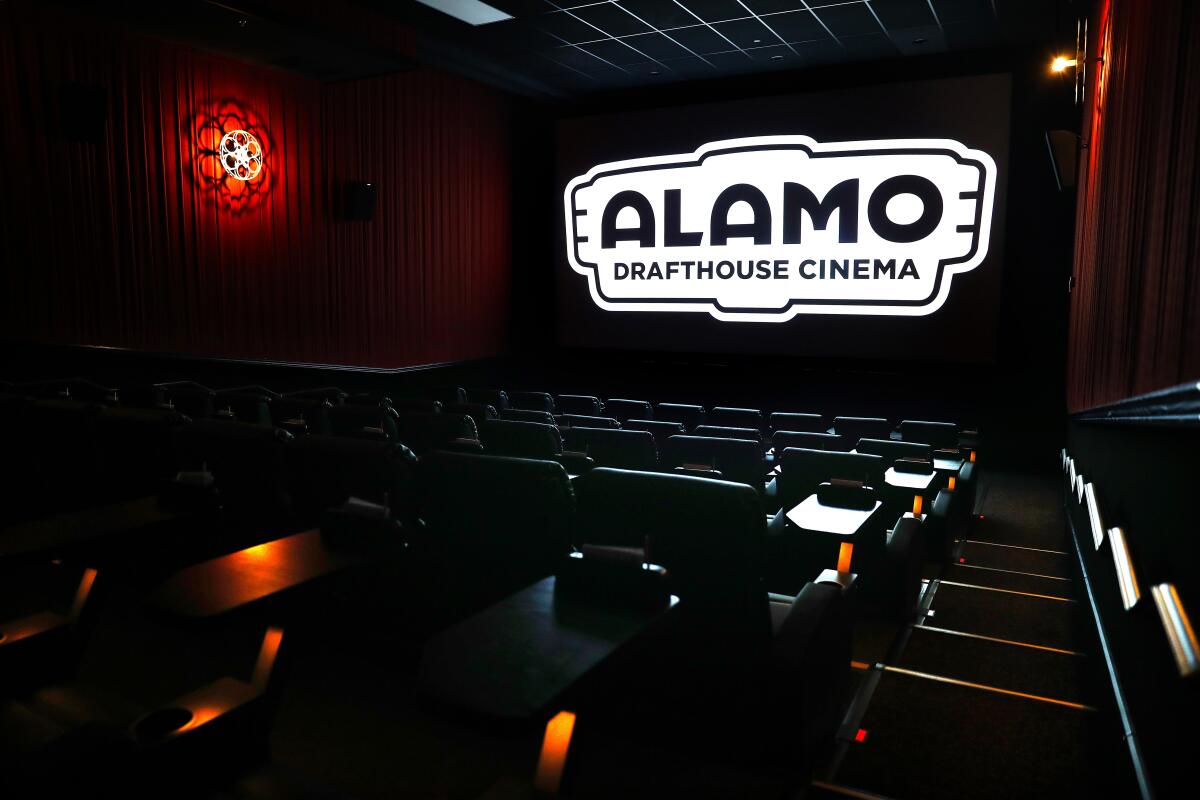
While the entire exhibition industry was under duress, the struggles of the indies were most keenly felt by L.A.’s community of fervent moviegoers and filmmakers. Such theaters, particularly the Dome, served as places to launch new movies with premieres and director Q&As. Under Tarantino, the Vista, a single-screen theater first erected in 1923, isn’t expected to reopen until around Christmastime.
But there are signs of hope for many struggling operators. After painful delays, theater owners have begun to receive desperately needed federal funds from the $16-billion Shuttered Venue Operators Grant program that was passed by Congress in December but hobbled by technical snafus and administrative delays.
Greg Laemmle, president of L.A.-based Laemmle Theatres, has been sifting through the paperwork before determining what to do with the capital from the recently approved grant. He said the infusion will be pivotal as the chain waits for specialty movies and their audiences to come back in full force.
“We’ve been thrown a lifeline, and we want to make sure we use the lifeline in the right way,” Laemmle said. “In an ideal world the lifeline is going to keep us open and operating until such time as people feel comfortable returning to movies.”
The process of bringing back patrons has been gradual since Laemmle reopened its Los Angeles locations, including the new Newhall theater in Santa Clarita, in April, several weeks after L.A. allowed movie theaters to reopen.
Weekday attendance has increased to about 200 people a day at some locations including the Playhouse 7 in Pasadena, double what it was in April, but nowhere near normal levels.
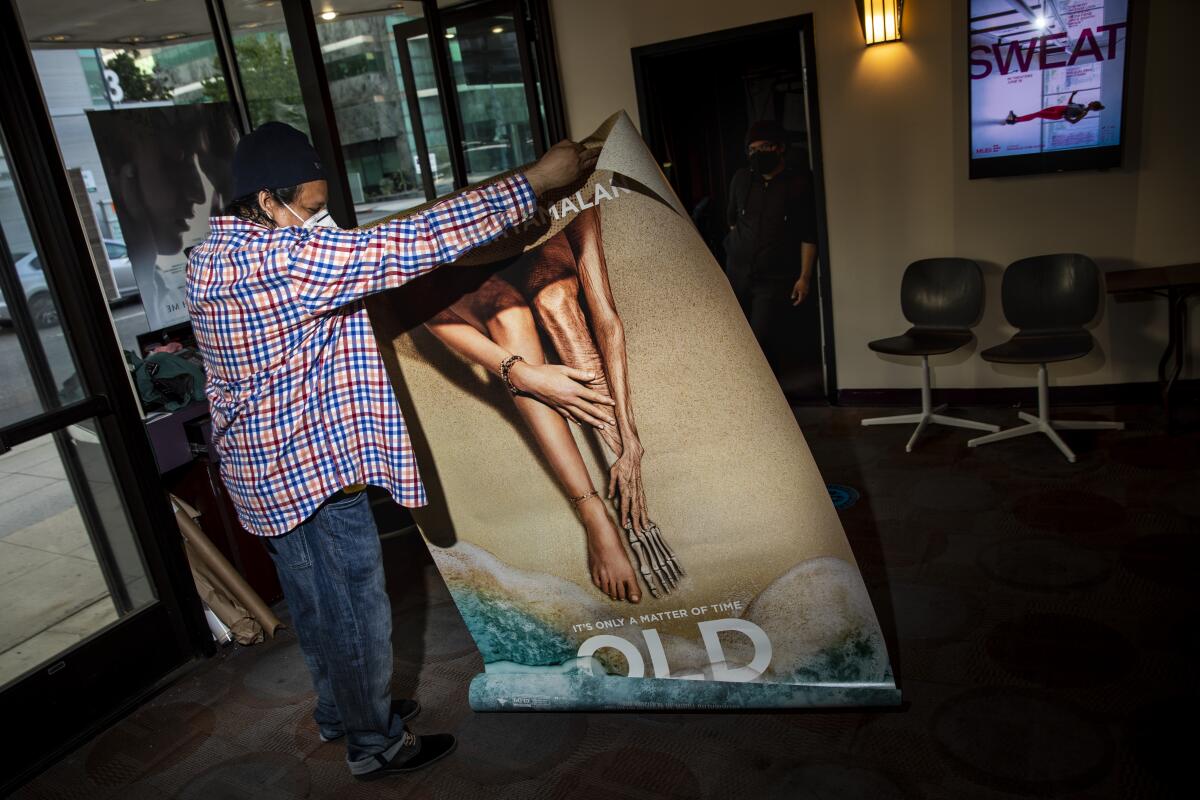
Laemmle’s key demographic, which tends to be older and thus more vulnerable to the virus, is the least likely to return right away, according to survey data.
Seventy-four percent of moviegoers ages 35 and over, are very or somewhat comfortable going back to a theater, compared with 84% of 17-to-34-year-olds, according to recent National Research Group numbers.
Laemmle acknowledges another challenge — that audiences have had a year and a half of being able to watch new movies in their living rooms.
“For our customers, moviegoing is a habit, and it’s a very important habit. And that habit has been broken,” Laemmle said. “We need to figure out how do we prime the pump and when is the right time to jump into that. We are fighting an uphill battle trying to reestablish the relationship right now.”
In some places, filmgoer communities have returned in a big way. Repertory screenings at the New Beverly Cinema, which Tarantino also owns, have played to sold-out crowds, the director said on “Armchair Expert.”
The 7-year-old nonprofit Frida Cinema in Santa Ana raised $26,000 through a “Nightmare on Elm Street” fundraiser marathon. The June 5 event started at 1 p.m. and ended at 3:30 a.m., said founder Logan Crow. The money raised, plus $90,000 in combined PPP loans, helped Crow and his six-person staff stay afloat.
“It was a very inspiring and rewarding feeling,” Crow said. “Our return and survival means as much to others as it does to us.”
Screenings of classic titles have also returned to the Aero Theatre in Santa Monica, operated by the nonprofit American Cinematheque. At the Aero, American Cinematheque is drawing in patrons with popular comedies and feel-good fare, including an upcoming Martin Brest double feature of “Midnight Run” and “Beverly Hills Cop.”

The group is also programming screenings at the Los Feliz 3 theater while its Hollywood home of the Egyptian Theatre undergoes renovations following its purchase by streaming service Netflix. At the Los Feliz location, owned by Vintage Cinemas, American Cinematheque plans to host 20 screening events a week, including art house titles, black-and-white classics and foreign cinema.
American Cinematheque deputy director Gwen Deglise said the Los Feliz programming strategy is a reminder of the organization’s days before it owned the Egyptian, when it would host screenings at venues as varied as the Hollywood Bowl, Raleigh Studios and the Directors Guild of America theater.
“What the pandemic taught us ... is that we’re defined by our programming, we’re not defined by our building,” Deglise said. “We’re defined by a belief that cinema is to be shared.”
For commercial art houses and independents, it won’t be until the fall movie season when theaters have a robust selection of top-shelf films to play.
Highly anticipated titles include Wes Anderson’s “The French Dispatch,” which just premiered at the Cannes Film Festival after being delayed a year by the pandemic, Edgar Wright’s time-bending thriller “Last Night in Soho” and the untitled latest from Paul Thomas Anderson, starring Bradley Cooper.
The Lumiere theater has found a slow-building success with an eclectic mix of titles, such as the comedy “Shiva Baby,” the documentary “The Truffle Hunters” and the quirky action tale “Nobody,” as audiences have steadily made their way back to the theater.
Ambrosio said there’s a built-in audience of people who are loyal moviegoers, such as those who come out for date nights and out of habit, because it’s just something they’ve always done. For the rest of the audience to come back, theaters need to be able to book films that excite them and generate passionate interest.
All of which leads to something of an existential question — what makes a movie theater? Is it the movies themselves, the specific titles that are playing, or is it something about the physical space, the people inside and the overall vibe of a place? Ambrosio recalled the moment it all clicked for him was when the theater was offered Terrence Malick’s World War II-set drama of religious faith, “A Hidden Life,” before the pandemic struck.
“And we sort of like looked at the situation, a distributor comes to you and you start to say, ‘Why are they trying to give us this movie?’” Ambrosio said. “And so we looked around and we said, ‘Wait a second, the new Terrence Malick movie isn’t playing in theaters in L.A. at all?’ As a film fan that offended me. So that’s where we kind of come from. We are going to provide people with the space to see those kinds of movies that they otherwise wouldn’t be able to see.”
More to Read
Inside the business of entertainment
The Wide Shot brings you news, analysis and insights on everything from streaming wars to production — and what it all means for the future.
You may occasionally receive promotional content from the Los Angeles Times.











